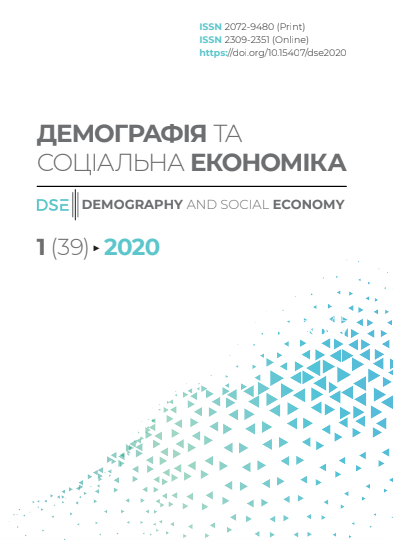DEMOGRAPHIC TRENDS IN MEGAPOLIS: A CASE OF THE EUROPEAN COUNTRIES
Keywords:
demographic processes, metropolis, population of large cities, gender-age structure of population of large cities, social infrastructureAbstract
The relevance of the research is due to the need to study the demographic processes of metropolitan areas, predict possible challenges and identify ways to overcome them. Demographic processes in metropolitan areas are very different from general demographic processes in countries in general. In terms of demographic characteristics, Kyiv differs from other regions of Ukraine, but its demographic development is in many ways similar to that of other European capitals where demographic processes have much in common. The purpose of the article is to identify the demographic trends in European capitals that are close in population numbers to Kyiv and to evaluate them thoroughly on the example of the capital of Ukraine. The novelty of the work in determining the patterns of demographic development of the capitals of Europe compared to the demographic processes in these countries. The study analyzes the demographic trends of Kyiv and compares them with the trends of a number of European capitals using the methods of comparison and generalization to determine the main demographic trends of the development of large cities. It is established that the decisive trends in the demographic development of capitals are the slow increase in the population of the capital against the background of the overall population decline in the country; aging of the population and decreasing share of the economically active population; development of social infrastructure as a competitive advantage of the city. With a significant decline in population in Europe, the population of their capital cities increases from 0.5 to 1 % annually. According to our calculations, the capital of Ukraine has about the same population growth rate as the European capitals close in population. International migrants are the main source of demographic growth for the capitals of Europe, while Kyiv is growing at the expense of internally displaced persons and internal migration. According to the UN, Vienna and Lisbon are projected to see the fastest population increase by 2035 (0.5-0.7 % annually), but these figures are significantly lower than those shown in Asia’s and Africa’s metropolitan areas. According to the research, capital cities tend to have a more progressive gender-age structure with a slightly higher proportion of young people and a smaller proportion of older people. At the same time, they also face challenges related to the population aging: increasing economic burden on the working population, transformation of the labor market, lack of adequate social infrastructure. Infrastructure development is a major competitive advantage of European capitals, which attracts migrants and creates comfortable conditions for the already existing population. Infrastructure problems significantly limit Kyiv’s growth. The spontaneous development of suburban territories and the delay in creating agglomerations that would balance the demographic and socio-economic development of the capital are also having an adverse effect.
References:
- UN Nation 2018 Revision of World Urbanization Prospects (2019). Retrieved from https://www.un.org/development/desa/publications/2018-revision-of-worldurbanization-prospects.html.
- Riederer, B., Verwiebe, R., & Seewann, L. (2019). Changing social stratification in Vienna: Why are migrants declining from the middle of society? Population, Space and Place. Retrived from: https://onlinelibrary.wiley.com/doi/10.1002/psp.2215.
- Cristea, M., Mare, C., Moldovan, C., China, A., Farole, T., Vințan, A., & IonescuHeroiu, M. (2017). Magnet cities : migration and commuting in Romania. Washington, D.C.: World Bank.
- Jaroszewicz, M. (2018). Migration from Ukraine to Poland: the trend stabilises. Warsaw: Ośrodek Studiów Wschodnich.
- Dragunova, T.A. (2005). Migration processes in large cities (case of Kyiv): PhD thesis abstract. Institute for Demography and Social Studies of the NAN Ukraine. Kyiv. Retrieved from: http://irbis-nbuv.gov.ua/cgi-bin/irbis_nbuv/cgiirbis_64.exe?Z21ID=&I21DBN=AR D&P21DBN=ARD&S21STN=1&S21REF=10&S21FMT=fullwebr&C21COM=S&S21CN R=20&S21P01=0&S21P02=0&S21P03=A=&S21COLORTERMS=1&S21STR=%D0%94 %D1%80%D0%B0%D0%B3%D1%83%D0%BD%D0%BE%D0%B2%D0%B0%20 %D0%A2.%D0%90.$ [in Ukrainian].
- Sanderson, W., & Scherbov, S. (2005). Average remaining lifetimes can increase as human populations age. Nature, 435, 811-813.
- Sanderson, W., & Scherbov, S. (2015). Faster increases in human life expectancy could lead to slower population aging. PLoS ONE. Retrived from https://doi.org/10.1371/journal. pone.0121922
- Aksyonova, S.Yu., Krimer, B.O., & Kurylo, I.O. (2014). Demographics of Ukraine: Imperatives of population aging. Retrieved from http://www.idss.org.ua/monografii/2014_ Naselennya.pdf [in Ukrainian].
- Denysenko, O. (2017). Ukrainian cities in the European metropolitan Network: how is Kyiv integrated? Urban Ukraine. In the Epicenter of Spatial Changes, 169-180 [in Uk rainian].
- Kramarenko, R.M. (2014). Capital in the global competitive model of economic deve lopment. DVNZ “Kyiv. nats. ekon. un-t im. V. Hetmana” [in Ukrainian].
- State Statistics Service of Ukraine (n.d.). Retrieved from http://www.ukrstat.gov.ua/ [in Ukrainian].
- Main Department of Statistics in Kyiv region (n.d.). Retrieved from http://kiev.ukrstat. gov.ua/ [in Ukrainian].
- 1 424 967 internally displaced persons (2019). Ministry of Social Policy of Ukraine. Retrieved from https://www.msp.gov.ua/news/17892.html [in Ukrainian].
- Eatock, D. (2019). Demographic Outlook For The European Union 2019. European Par liamentary Research Service Blog.
- Population structure by major age groups, EU-28, 2016-80 (2017). Eurostat. Retrieved from https://ec.europa.eu/eurostat/statistics-explained/index.php?title=File:Population_ structure_by_major_age_groups,_EU-28,_2016-80_(%25_of_total_population).png.
- Kyiv City Development Strategy for 2025 (2017). Kyiv City State Administration. Retrie ved from https://dei.kyivcity.gov.ua/files/2017/7/28/Strategy2025new.pdf [in Ukrainian].
- Ukraine - Urbanization review (2015). World Bank. Retrieved from http://documents. worldbank.org/curated/en/213551473856022449/Ukraine-Urbanization-review.
Downloads
Published
How to Cite
Issue
Section
License
Copyright (c) 2020 Віта Думанська

This work is licensed under a Creative Commons Attribution-NonCommercial-NoDerivatives 4.0 International License.


